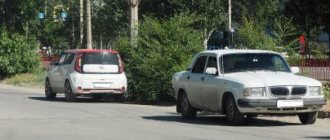What are the overall dimensions of a parking space for a car?
The increasing number of vehicles creates problems for car owners with parking.
The areas allocated for this are sorely lacking, so unscrupulous drivers often break the rules by abandoning cars in the wrong places.
Abandoned vehicles create problems on the road, leading to congestion, limited road visibility, and sometimes accidents occur due to such vehicles.
How to determine the size of a parking space.
What is parking (introduction to terminology)
In modern conditions, the main most commonly used terms related to the automotive industry are regulated by regulations. Physical parameters are also standardized where possible.
Parking is a specially designated area for wheeled vehicles, with a road fence, clear markings on the road surface and marked with a special sign. A place for a car can be provided both free of charge (at publicly significant places, government institutions, etc.) and on a paid basis (private or municipal parking lots).
Recently, accounting in municipal parking lots has been transferred to an automated mode, which is helped by the Parkon system.
To transfer the territory to the official legalized parking status, it is necessary to formalize the selected site and register it in accordance with the established requirements of the law and state standards (GOST). One of the main regulatory documents in this case is SNiP SP 113.13330.2016 “Car Parking”.
The driver has rights and responsibilities according to which he can park in the following ways:
- in designated areas where there is an appropriate road sign;
- pulling over to the side of the road;
- on the edge of the road, while the car must be located parallel to the direction of traffic; a partial collision with the sidewalk is allowed if there is a special sign installed.
A classic parking lot differs from a parking lot in that the latter is part of the road. It is legally prohibited to park a car in a green zone, on lawns or areas for the disabled unless there is a special sign on the car.
You should know the term “car space,” which is part of a structure or building and has clear, fixed boundaries.
A car or truck, as well as a bus or trailer can be located within the established limits in accordance with the permissible dimensions.
Types of parking by type of car placement
Based on the operational characteristics of passenger cars, it is possible to place them in specially designated areas in three ways:
- parallel to the direction of movement;
- perpendicular to the main axis of the road;
- “herringbone” (at an angle to the main direction of traffic).
Each option has pros and cons for specific road conditions. In each case, it is worth considering that the width of a parking space for a GOST car for passenger vehicles is limited to 2.5 m. This format will allow you to freely open the door of a medium-sized car without touching the car standing next to it.
Parallel type
The method of installing the car involves placing it close to the sidewalk along the main roadway. A significant disadvantage of this configuration is the ability for a large number of cars to park in a certain area.
This type of car location is relevant for narrow city streets. The disadvantage is that a car parked parallel to the sidewalk can easily be blocked by cars located in front and behind.
It is difficult for new drivers to escape from such a trap.
Perpendicular parking method
The car is positioned at a 90 degree angle to the sidewalk or road. The format allows you to squeeze the maximum amount of transport into a small space. Not all drivers can easily position the vehicle body in this way.
In addition to the positive of compactness, the method has a disadvantage. Statistics prove that it is when leaving such parking lots that a significant number of minor accidents occur. Drivers should be especially careful in heavy traffic.
We recommend using someone’s help, who will tell you the timeliness of the maneuver to leave.
Herringbone parking
For large spaces, parking lot owners may suggest placing cars at an angle of approximately 45 degrees to the sidings. From above, the platform with transport resembles Christmas trees.
It is believed that this type of arrangement is most convenient for novice motorists. It is much easier to enter the desired area than to a perpendicular area.
However, even with a visually high density, the workload of the herringbone is one third less than that of its perpendicular counterpart.
Parking areas
Certain rules apply to the choice of parking locations. Having selected a site of sufficient size, it is necessary to take into account its distance from public places and any environmental objects.
At the same time, it is important to ensure maximum parking safety from external, potentially negative factors. According to parking rules, the norm for a passenger car should be 5.3x2.5 m, and for wheelchair users 6x3.6 m.
If the site accommodates 10 cars, then it is important to ensure a distance of 10 m from a public building or residential building. The minimum distance of 25 m should be observed for the following objects:
- hospital;
- kindergarten;
- playground or sports ground;
- educational institution;
- park or square.
If the potential number of cars is in the range of 10-50 units, then such a distance should be at least 50 m, and the distance from residential buildings should be at least 15 m. When the number of parking spaces increases to 100 units.
, both intervals must be at least 25 m. Large sites for 300 cars are located 35 m from houses and 50 m from schools, kindergartens, etc. Up to 500 cars can be placed no closer than 50 m from houses and educational institutions .
It is recommended to locate 500 or more parking spaces in industrial zones.
Parameters of a parking space in an open parking lot
According to established SNiP, a standard passenger car is allocated a site with the following dimensions:
- width – up to 2.5 m;
- length – at least 5.3 m.
Important! When allocating parking space for a car, the area hidden by the markings is not taken into account, which additionally takes about 0.1 m2.
Designers assume that an ordinary car has average dimensions of 4.4x1.8 m. Accordingly, according to GOST, a space of 13.25 m2 is allocated for it. The area per car in different situations can only vary upward. Based on the established parameters, it is easy to calculate the required parking space.
With a parallel type of arrangement and a gap of 1 m, two cars will occupy 4.4 + 1 + 4.4 + 1 = 10.8 m in length, and with a perpendicular one, 4.4 + 1 + 4.4 = 9.8 m. Comfortable exit for the passenger will be ensured with a width of 1.8+1=2.8 m, which is consistent with the requirements of the regulations. When parking in a herringbone pattern, 8.8 m is allocated for the length of the car.
, and the occupied area will be at least 18 m2.
Technical requirements for marking parking spaces
Basic technical requirements include not only the organization of the work area where the machines will be located, but also the selection of materials from which the entire incoming infrastructure is supposed to be made. Such objects include the fencing used, as well as the markings used. The important points are as follows:
- in the area of the local area, the boundaries of the parking lot must be clearly distinguishable, so side stones are used for zoning;
- vertical elements must be painted in courtyard parking lots with special reflective markings in order to be visible in the dark;
- To paint asphalt, you must use nitro paint or thermoplastic.
You should not use cheap water-based markings. It quickly wears off from moisture and precipitation, making it impossible to determine the boundaries of the parking lot. It is important to locate places for people with disabilities as close as possible to the entrances of buildings.
Thanks to the expanded space on them, the driver will be able to open the stroller. There should be 10% of such places.
Motorists can park their cars on such a site if they have the appropriate sign on the car and a certificate of disabled people of group 1 or 2, otherwise a fine of 5,000 rubles will be issued.
Conclusion
The organization of parking should not create obstacles for other road users. In narrow areas it is worth parking the car along the traffic. Although it is easier to park the car in a herringbone pattern, this is not acceptable everywhere, so you need to train well in advance to drive out of cramped conditions. From 2020, a parking space can be sold or even inherited.
The fate of existing parking spaces
Parking signs on even and odd days of the month in Russia in 2018
In Part 1 of Art. 6 of Law No. 315-FZ states that a property that meets the requirements and characteristics of a parking space and the rights to which were registered before the date it came into force is recognized as a parking space.
At the same time, the requirements for the minimum and maximum size of parking spaces, information about which is already reflected in the Unified State Register, will not apply.
Previously issued documents do not need to be reissued; they retain their legal force. But the owners of the corresponding parking spaces are not deprived of the right to submit an application to the registration authority to change information about the objects that are indicated as premises as parking spaces. There would be a desire!
What should people do whose parking spaces were registered as a share in the right of common ownership? Here, too, everything is not so complicated, the situation is resolved in Part 3 of Art. 6 of Law No. 315-FZ.
The owner of a share can allocate his share in kind by defining the boundaries of a parking space in accordance with the requirements of Law No. 218-FZ and register ownership of it.
To register a parking space for cadastral registration, you must confirm your right to it by submitting to Rosreestr an agreement of all co-owners or a decision of the general meeting, which determines the procedure for using real estate that is in common shared ownership.
If there is no agreement or decision, in this case, in order to allocate your share, you will have to obtain the consent of other participants in shared ownership.
As soon as all available parking spaces are allocated in kind and registered, the common shared ownership of the premises within the boundaries of which they are located ceases. Only the property remaining after the allocation of shares and necessary for passage or access to parking spaces will be common.
Let's summarize all of the above.
From January 1, 2020, parking spaces become independent real estate objects.
The parking space is subject to state cadastral registration, and ownership of it can be registered.
It may be the subject of a mortgage (Clause 6, Part 1, Article 5 of Federal Law No. 102-FZ of July 16, 1998 “On Mortgage (Pledge of Real Estate)” - introduced on January 1, 2017).
A property that meets the requirements and characteristics of a parking space and the rights to which were registered before the entry into force of Law No. 315-FZ is recognized as a parking space.
The owner of a parking space as a share in the right to common property may demand the allocation of a share in kind and registration of ownership of it.
Thus, from January 2020, parking spaces are officially recognized as real estate. They are distinguished from ordinary premises only by the absence of material, tangible boundaries in the form of walls and partitions.
For a more complete understanding, I suggest watching one of the episodes of Anton Ivanov’s channel about the legal regime of parking spaces. In addition to Anton Ivanov himself, Alexandra Aleksandrovna Makovskaya takes part in the program.
Part 1. Car spaces in the real estate system.
Part 2. Features of the legal regime of parking spaces.
I hope that the article was useful and that the changes in legislation regarding parking spaces became clearer to you.
Albert Sadykov / author of the article
The site uses cookies to recognize you and obtain information about your user experience. When you visit website pages, your data is processed using web analytics systems. If you agree to this, you may continue to use the site. Otherwise, change your browser settings or leave the site I agree
Dimensions of parking spaces in an open parking lot according to parking standards - BTI
The increasing number of vehicles creates problems for car owners with parking.
The areas allocated for this are sorely lacking, so unscrupulous drivers often break the rules by abandoning cars in the wrong places.
Abandoned vehicles create problems on the road, leading to congestion, limited road visibility, and sometimes accidents occur due to such vehicles.
How to determine the size of a parking space.
Size of parking space for a car
Since 2020, several changes have been made to the legislation on the size of parking spaces - now minimum and maximum parameters are provided for cars and other cars. Along with this, a parking space in the yard is recognized as real estate - accordingly, it can be bought, sold and registered as a property, just like an apartment.
- Expert opinion
- Sobolev Dmitry
- Administrative offenses lawyer, website expert
It is also important to know what is considered the adjacent territory of an apartment building - we previously discussed this issue in detail here.
Parking sizes: latest changes in legislation 2018
All dimensions of the parking space are reflected in SNiP 21-02-99, in force since 2011. According to this document, parking parameters for a passenger car should be as follows:
- width 2.5 meters;
- length 5.3 meters.
In this case, the width of the marking (up to 0.1 meters) is not included in the dimensions of the parking space.
In the case of parking for disabled cars, all parameters increase:
- length – 6.2 meters;
- width – 3.6 meters.
As a rule, near hospitals, large shopping centers, shops, cultural institutions and in modern residential neighborhoods, 10 to 20% of the total parking area is allocated for the disabled.
The same document specifies technical requirements for the organization of parking space, parameters of materials used for fencing the territory, in particular:
- The boundaries of off-street parking should always be fenced off using curbstones.
- In courtyards and other places, reflective markings must be created (on poles and other vertical supports).
- Thermoplastic or nitro paint is used for marking on the asphalt surface. However, in most cases, a cheap water-based mixture is used, which disappears completely in 1 season due to precipitation.
The latest changes in legislation, which came into force on January 1, 2020, established that the minimum parking size is now 5.3 * 2.5 meters, and the maximum corresponds to the indicators for cars of disabled drivers.
NOTE. Also, as of January 1, a parking space became a recognized piece of real estate. This means that now it can be bought with a mortgage (together with the apartment), sold, bequeathed, and also registered as property, like any other real estate object.
Preparation for marking work
Before work on marking the territory is carried out, a location is selected and the total number of parking spaces and the features of their location are calculated based on several considerations:
- What kind of cars will the parking be intended for? Most often, parking is provided only for cars, since special zones are created for trucks.
- How large the gaps between the borders can be left is usually based on ensuring that 1 person can freely pass between the cars.
- How exactly cars will be parked – lengthwise or widthwise (type of parking).
Along with these circumstances, secondary factors (thickness of markings, fencing - general or individual), and aesthetic considerations are also taken into account.
Procedure and cost of marking
When applying markings, the following rules are followed:
- Optimal weather is dry and warm (from +18°C to +25°C).
- The materials used are thermoplastic, paint or polymer tapes.
- Deviation from the permissible dimensions of a parking space is no more than 5 cm in each direction.
The sequence of actions is as follows:
- Preparing the material (paint, paint) for work.
- Preparing the area for work - clearing the previous markings (they should completely disappear), as well as removing dust and debris.
- Drawing a preliminary contour in accordance with the parameters.
- Paint each contour until you get straight lines.
- Improvement of the parking lot - marking special areas (for the disabled), painting pillars with fluorescent paint (for example, highlighting places with fire extinguishers), applying numbering and other means for easy navigation through a large parking area.
Types of open parking in courtyards
According to the Housing Code, car owners have the right to arrange parking near their home. But there are a number of requirements that must be observed in such cases. Such sites cannot accommodate more than 50 vehicles. They should be placed at a distance of at least 10 meters from high-rise buildings. Parking in the local area can be organized in different ways. Depending on their location and shape, there are several types of parking:
- ground (in which half the area of the upper part of the external fences is openings, the rest is parapets);
- embanked (buried parking lot with enclosing structures above ground level);
- detached (outside the home, but in the area adjacent to it);
- flat (site without a built foundation);
- attached (adjacent to the boundaries of the house).
Parking for disabled people is indicated by a special sign.
Each parking space option should be designed according to the standards established by law. Parking lot markings according to GOST are selected based on the total area and type of vehicles used by residents. It is permissible to arrange the machines in a “herringbone” shape, in several rows, across, parallel and obliquely.
When choosing a method for demarcating a parking lot, the dimensions of the vehicles placed there and the category of car owners are taken into account.
Some Russians have a number of privileges in this regard. To obtain them you will need to prove your special status.
Size of parking space according to GOST: area and dimensions of a standard space for 1 car
Every car owner today is sure: any trip in a major city turns into an exciting adventure called “Find a free parking space.” It is especially difficult to find parking in the courtyards of old houses and in the historical centers of megalopolises, where the urban planning plan simply does not provide for the number of cars that we have today.
The size of a parking space is determined according to GOST, and knowing this information, it is easier to defend your rights if, for example, your car is dented due to a narrow passage in the parking lot.
Dear readers! Our articles talk about typical ways to resolve legal issues, but each case is unique.
If you want to find out how to solve your particular problem, please contact the online consultant form on the right or call +7 8
It's fast and free!
What is parking
Parking is a designated area that must have a fence, markings and an appropriate road sign. Parking spaces are provided free of charge, for example, in public parking lots or for a fee in private or municipal parking lots. The latter most often use the automated Parkon system.
In order for a territory to receive official parking status, it must be registered and formalized in accordance with all legal requirements. To date, parking parameters are reflected in the document SNiP SP 113.13330.2016 “Car Parking”.
Parallel
Typically used along roadways or sidewalks. Its main drawback is that few cars can fit, and if the cars are placed close to each other, then it is very difficult to enter and exit such a place, especially for a beginner. There is only one plus: such parking may be closest to your destination.
Perpendicular
Parking a car at an angle of 90 degrees with respect to the roadway is quite difficult, but this type of parking has the greatest capacity. But according to statistics, it is in such parking lots that accidents most often occur, especially if a car drives straight out of the parking space onto the roadway.
"Herringbone"
Parking spaces are located at an angle of 45 degrees, and from a height the markings resemble a Christmas tree, hence the name. This type is the most convenient for the driver, it is much easier to make a parking maneuver, even a beginner can handle it, passages between rows of cars in this case are already made, but still the capacity of such a parking lot is 30% lower than that of a perpendicular one.
Parking locations
The location of the future parking depends on many factors: firstly, on its size (number of parking spaces), and secondly, on the distance from environmental sites and public places. Parking must be safe. And there are many potential threats from such structures, even outdoors: fires, accidents, gasoline leaks and exhaust fumes.
On the other hand, if you are a car owner, then you are looking for parking closer to the place where you are going, and the prospect of walking a few dozen extra meters to the office, shopping center, hospital or other public place does not appeal to anyone.
Reference. The distance from the parking lot to urban planning objects is regulated by the document SP 113.13330.2012 “Car Parking”.
Car parks for 10 cars or less are located at a distance of 10 m from residential buildings and public buildings. There must be at least 25 meters to the territory of kindergartens and schools, hospitals, playgrounds and sports grounds, as well as city parks and squares.
Parking lots for 10–50 spaces are located 15 m from the walls of residential buildings with windows, and exactly twice as far (50 m) from kindergartens, schools, hospitals, etc.
Open parking lots with a capacity of up to 100 cars will be located 25 meters from residential buildings, but the distance to the territories of children's institutions, hospitals and recreational facilities for them will not be increased.
Large parking lots, up to 300 cars, should be located 35 m from residential buildings with windows, 50 m from children's institutions, be it a school, vocational school or kindergarten, and 60 m from medical hospitals, sports stadiums and places of recreation for citizens.
Parking lots for more than 300 cars must be located 50 m from the windows of residential buildings; other requirements do not change. And huge parking lots accommodating more than 500 cars are recommended to be located in industrial zones.
The placement of open parking lots is prohibited in areas of water intake for domestic and drinking purposes; SanPiN 2.1.4.1074 is responsible for this.
Size of parking space in open parking
The area of a standard parking space for 1 car is very easy to calculate, knowing that the minimum parameters are as follows:
- parking space width - 2.5 meters;
- parking space length - 5.3 meters;
The width of the markings (0.1 meters on each side) is not taken into account. It turns out that the area of the minimum parking space is 13.25 square meters. m.
Important! It is believed that the standard length of the car is 4.4 meters and the width is 1.8.
At the discretion of the owner, the size of parking lots can be increased. So, for example, to create comfortable parallel parking, the length of one space should be equal to the length of two standard cars (8.8 m), but the width should be equal to the width of a standard car plus another 1 meter for the safety of the exiting driver and passenger (1.8 m + 1 m = 2.8 m).
But for parking at an angle of 45 degrees, more space will be required; according to standards, the area of one such parking space is 18 square meters. meters.
The maximum dimensions of a parking space for disabled people :
- width - 3.6 meters;
- length - 6.2 meters;
Deviation from the specified dimensions is allowed, but no more than +/– 5 cm. Such dimensions are primarily due to fire safety measures, and also reduce the risk of accidents in parking lots.
Parking spaces for disabled people
Among car owners there are many people with disabilities, especially those who use a wheelchair. Special standards have been developed for these citizens: firstly, the parking space has been increased (3.6 × 6.2 m) so that a wheelchair can easily pass between the rows of cars, and secondly, they must be located on the territory closest to the entrance to the building.
Spaces for disabled people occupy 10–20% of the main parking area. As a rule, places with a special sign are found in parking lots near new residential complexes, shopping centers, shops, hospitals and other public buildings.
How to choose the right place for future parking?
Garages are extremely rarely installed on summer cottages, since their construction is a labor-intensive, expensive and lengthy procedure. It is much more profitable to arrange a parking space next to your house, especially if you do not live there permanently.
The size of the future parking lot depends on the type of parking and the dimensions of your car.
First of all, it is important to choose a suitable place for future parking. Typically, car owners try to place it as close to the house as possible to make it more convenient to monitor the vehicle and, if necessary, load the vehicle with products from the summer cottage.
You can sacrifice a few meters of your land or garden to create a parking space.
The following types of parking are distinguished:
- open (they are a flat area without a canopy, covered with asphalt, concrete, stone, tiles or crushed stone);
- open with a polycarbonate canopy (allows you to protect the car from the scorching sun and various precipitation);
- environmental (otherwise called lawn parking lots; when arranging them, it is necessary to preserve as much greenery as possible);
- closed (i.e. garages, the owner can also install heating and light into the room).
The latter option is especially relevant if parking is required near a private house in which the owner lives on a regular basis.
Useful information : How to find out what you owe for gas?








